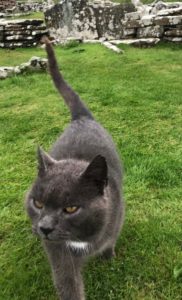In which Sid and Doris see a broch, a brough and two seals, but do not risk being marooned.
 Today we go north on Mainland Orkney and our first stop is the Broch of Gurness. On the Covid-internet this is shown as being “temporarily closed” (ie for the foreseeable future) but in fact the ticket booth is closed and the Broch itself is open and gloriously empty of anyone else.
Today we go north on Mainland Orkney and our first stop is the Broch of Gurness. On the Covid-internet this is shown as being “temporarily closed” (ie for the foreseeable future) but in fact the ticket booth is closed and the Broch itself is open and gloriously empty of anyone else.
 With the island across the water completely undeveloped, you can stand here alone and see what the people then saw. Apart from a cat who proclaimed its mastery of the site and then tried to adopt us. But Sid and Doris are made of sterner stuff.
With the island across the water completely undeveloped, you can stand here alone and see what the people then saw. Apart from a cat who proclaimed its mastery of the site and then tried to adopt us. But Sid and Doris are made of sterner stuff.
We are on our way to the Brough of Birsay, a hill home of the Picts that is the other end of a short causeway. We could get across but the tide will soon be too high to get back. Inland at Birsay village Earl Thorfinn the Mighty built a Christchurch cathedral for his new Bishop. Either they were religious on Sundays or had given up much of their Viking. Or perhaps when they overtook Iceland and Greenland in 1264 the Vikings were on a mission from God to erm, ah, ‘Bishop please could you bless this heavily armed band of beardy chaps and that long boat with the gaily coloured sail’?
 We are dressed in stout (but not stout enough) boots, waterproof trews, waterproof coats, hats and gloves. The rain is cold and wind driven. We walk along the sea shore. There are small brown birds dribbling about in the brown kelp. We may have seen birds that were not shags. After that we have little to report except the extreme excitement of seeing two seals – who we would not have noticed except that they “harrumphed” at us to gain our attention. We squelch on knowing that we are in touch with nature.
We are dressed in stout (but not stout enough) boots, waterproof trews, waterproof coats, hats and gloves. The rain is cold and wind driven. We walk along the sea shore. There are small brown birds dribbling about in the brown kelp. We may have seen birds that were not shags. After that we have little to report except the extreme excitement of seeing two seals – who we would not have noticed except that they “harrumphed” at us to gain our attention. We squelch on knowing that we are in touch with nature.
 As always Doris is keen to avoid an “out and back” walk, and although that means we trudge down a main-ish road for a bit (dryer underfoot, says the ever-positive Doris), it also takes us past this extremely neat garden observatory. Not much to observe today admittedly, but we believe that the skies are clear here sometimes.
As always Doris is keen to avoid an “out and back” walk, and although that means we trudge down a main-ish road for a bit (dryer underfoot, says the ever-positive Doris), it also takes us past this extremely neat garden observatory. Not much to observe today admittedly, but we believe that the skies are clear here sometimes.

